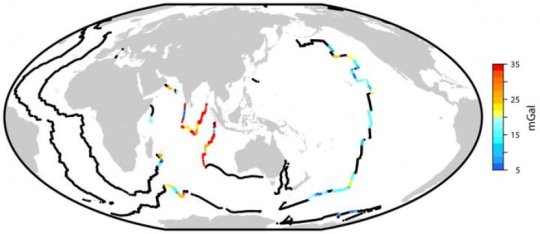@WFS,World Fossil Society,Riffin T Sajeev,Russel T Sajeev
New University of Oregon research has identified gravity-related fluctuations dating to 66 million years ago along deep ocean ridges that point to a “one-two punch” from the big meteor that struck off Mexico’s Yucatan peninsula, possibly triggering a worldwide release of volcanic magma that could have helped seal the dinosaurs’ fate.
“We found evidence for a previously unknown period of globally heighted volcanic activity during the mass-extinction event,” said former UO doctoral student Joseph Byrnes.

Colored and black points mark the global distribution of mid-ocean ridges, with ages of 66 million years ago created at spreading rates above and below 35 millimeters a year, respectively. Colors indicate the maximum gravity anomaly within 2 degrees.
Credit: Courtesy of Joseph Byrnes
The study by Byrnes and Leif Karlstrom, a professor in the UO’s Department of Earth Sciences, was published Feb. 7 in Science Advances. It details a record of volcanism preserved along the mid-ocean ridges, which mark the oceanic boundaries of tectonic plates. The evidence comes from changes in the strength of gravity above the seafloor.
The findings of the UO’s National Science Foundation-supported study, Karlstrom said, point to a pulse of accelerated worldwide volcanic activity that includes enhanced eruptions at India’s Deccan Traps after the Chicxulub impact. The Deccan Traps, in west-central India, formed during a period of massive eruptions that poured out layers of molten rock thousands of feet deep, creating one of the largest volcanic features on Earth.
The Deccan Traps region has been in and out of the dinosaur debate. Rare volcanic events at such a scale are known to cause catastrophic disturbances to Earth’s climate, and, when they occur, they are often linked to mass extinctions. Huge volcanic events can eject so much ash and gas into the atmosphere that few plants survive, disrupting the food chain and causing animals to go extinct.
Since evidence of the meteor strike near present-day Chicxulub, Mexico, surfaced in the 1980s, scientists have debated whether the meteor or the Deccan Traps eruptions drove the extinction event that killed off all nonavian dinosaurs.
Progressively improving dating methods indicate that the Deccan Traps volcanoes already were active when the meteor struck. Resulting seismic waves moving through the planet from the meteor strike, Karlstrom said, probably fueled an acceleration of those eruptions.
“Our work suggests a connection between these exceedingly rare and catastrophic events, distributed over the entire planet,” Karlstrom said. “The meteorite’s impact may have influenced volcanic eruptions that were already going on, making for a one-two punch.”
That idea gained strength in 2015 when researchers at the University of California, Berkeley, proposed that the two events might be connected. That team, which included Karlstrom, suggested that the meteorite may have modulated distant volcanism by generating powerful seismic waves that produced shaking worldwide.
Similar to the impacts that normal tectonic earthquakes sometimes have on wells and streams, Karlstrom said, the study proposed that seismic shaking liberated magma stored in the mantle beneath the Deccan Traps and caused the largest eruptions there.
The new findings at the UO extend this eruption-triggering in India to ocean basins worldwide.
Byrnes, now a postdoctoral researcher at the University of Minnesota, analyzed publicly available global data sets on free-air gravity, ocean floor topography and tectonic spreading rates.
In his analyses, he divided the seafloor into 1-million-year-old groupings, constructing a record back to 100 million years ago. At about 66 million years, he found evidence for a “short-lived pulse of marine magmatism” along ancient ocean ridges. This pulse is suggested by a spike in the rate of the occurrence of free-air gravity anomalies seen in the data set.
Free-air gravity anomalies, measured in tiny increments call milligals, account for variations in gravitational acceleration, found from satellite measurements of additional seawater collecting where the Earth’s gravity is stronger. Byrnes found changes in free-air gravity anomalies of between five and 20 milligals associated with seafloor created in the first million years after the meteor.
- Joseph S. Byrnes, Leif Karlstrom. Anomalous K-Pg–aged seafloor attributed to impact-induced mid-ocean ridge magmatism. Science Advances, 2018; 4 (2): eaao2994 DOI: 10.1126/sciadv.aao2994
- University of Oregon. “A one-two punch may have helped deck the dinosaurs: Seafloor data point to global volcanism after Chicxulub meteor strike.” ScienceDaily. ScienceDaily, 7 February 2018. <www.sciencedaily.com/releases/2018/02/180207142713.htm>.
@WFS,World Fossil Society,Riffin T Sajeev,Russel T Sajeev



 February 12th, 2018
February 12th, 2018  Riffin
Riffin  Posted in
Posted in  Tags:
Tags: 